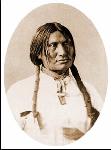
Chief Big Foot
Also known as Si Tanka Spotted Elk Big
Foot's band of Lakota,
destined to become the victims of the massacre at Wounded
Knee.

Big
Foot's band of Lakota,
destined to become the victims of the massacre at Wounded
Knee.
Among the last, haggard bands to return from the Badlands was that of Big Foot.... He tried to find safety at the town of Pine Ridge, but the soldiers found him first. Dying of pneumonia, Big Foot surrendered peacefully. He had the misfortune to fall into the hands of the Seventh Cavalry. Officers and men were revengeful and trigger-happy. They brought the Indians to a campsite near Wounded Knee, already well within the borders of the reservation.
Big Foot's group was surrounded by three thousand men. Guns were trained on them. Then their wagons and blankets were searched for weapons. A medicine man named Yellow Bird made the soldiers nervous by throwing dust at them and uttering war cries. A deaf-mute boy [probably Black Fox] dropped and accidentally discharged an old rifle. This was the signal for a general massacre. The Indians had been disarmed. They did not even have a half dozen weapons left. Chief Big Foot was shot down in the soldiers' tent where he had been under medical care. The Hotchkiss guns were pouring shells into groups of mothers and children. Out of 250 Indians, 200 were killed, 62 of them mothers and children.
The soldiers had about sixty men killed and wounded, most of them by their own bullets. As the soldiers fired into the camp from opposite sides, they naturally hit many of their own comrades. The bodies of the Indians, frozen stiff into grotesque postures, were stacked up like corded wood and buried together in a ditch. A photographer took pictures. The soldiers would have souvenirs to send back to their families.
From: Richard Erdoes, The Sun Dance People: The Plains Indians, Their Past and Present, New York, NY, 1972, pp. 184-186
SPOKEN INTRO:
But the land was already claimed by a people
when the cowboy came and when the soldiers came.
The story of the American Indian is in a lot of ways a story
of tragedy,
like that day at Wounded Knee, South Dakota.
|
Big Foot was an Indian chief Of the Minneconjou band, A band of Minneconjou Sioux From South Dakota land. Big Foot said to Custer, Then Big Foot led his people Big chief Big Foot, Big Foot was down with a fever Two hundred women and children An accidental gunshot Big chief Big Foot, Then smoke hung over the canyon Farther on up the canyon One side called it a "massacre,"
Big chief Big Foot, |
Chief
Big Foot After the Massacre of Wounded Knee:
This photograph shows the body of Big Foot,
lying in the snow after the massacre at Wounded Knee.
![]() Return to Indigenous Peoples' Literature
Return to Indigenous Peoples' Literature
Compiled by: Glenn
Welker
ghwelker@gmx.com
This page last updated 05/26/2019 14:44:38
This site has been accessed 10,000,000 times since February 8, 1996.